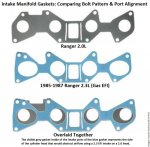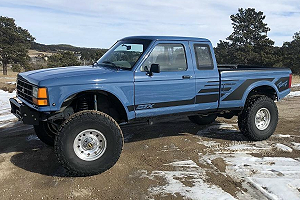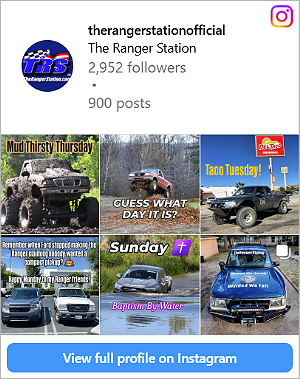kishy
Well-Known Member
- Joined
- Jan 9, 2018
- Messages
- 179
- Reaction score
- 71
- Location
- ON, Canada
- Vehicle Year
- 1985
- Make / Model
- Ranger, RCLB
- Engine Size
- 95 2.3 EFI Swap
- Transmission
- Manual
- 2WD / 4WD
- 2WD
Hey folks. First post here. Tried posting this on FRF first but the trend I've noticed there is that there is typically very little posting activity surrounding the early trucks, so I'm not too optimistic that I will find my answers there. I have searched a fair bit and can't find any references to anyone doing this, so it's either "a very dumb idea" or "literally not possible", but here we go.
My vehicle is a 1985 Ranger, 2.0L w/non-feedback YFA, TK5, RWD. Manual steering, no a/c. It is a Canadian market truck if this changes anything. The truck is the absolute definition of a beater and I am aiming for "functional result", not "perfection".
What I want to do is (first preference) swap in a good 2.3 w/EFI. However, finding a good engine is not a simple thing, so my second choice is to equip the 2.0 with EFI. I realize this is a ludicrous idea from a performance perspective, but my goal is excellent year-round driveability including below-0-Fahrenheit winters, and EFI is the best path to get there when compared to a carb that has a really worn out throttle body. I'd also like to put in a remote starter which is more complicated with a carb.
Big Question 1:
Is there some combination of intake parts (upper/lower) and fuel delivery (rail, injectors) that can be physically bolted onto my 2.0, which will cooperate with a MAF EEC-IV management system?
Big Question 2:
Assuming the stuff will line up well enough...what's the power loss (if much) going to be like slamming all that air into the "wall" around the intake port, due to the manifold runners being bigger than the ports on the head? Better than a poorly running carb 2.0 but less than a good condition 2.3 is what I'm aiming for.
Here's what I think I know already:
Outstanding questions (irrelevant if the answers to 1 and 2 above are not favourable):
3. Does the crank position sensor trigger wheel attach directly to the crank pulley? If so I can just grab the whole pulley off a junkyard truck.
4. Will the crank pulley off a 93 or 94 2.3 fit directly onto the crank of a 2.0?
5. What do I need to do for mounting the crank position sensor? I'm seeing some references to needing to replace the "front cover" of the engine but it isn't clear if that's just the plastic timing cover or something else (no pics anywhere).
6. Will running the ignition electronics (coilpacks, module) with half the spark plug outputs disconnected (single plug head) cause those parts to prematurely fail? If this is a waste spark system then can I get away with using only one coilpack?
Given all of the above, what would the parts list be? E.g. lower intake off an 85-?? EFI 2.3, upper intake off a ??, zip tube and MAF off a 93-94, etc.
I spend a lot of time in u-pull style junkyards and am not afraid of the physical work involved, nor am I afraid of the wiring (but I will say, those 93-94 harnesses are ugly...body electrical integrated into the same loom as the engine).
I'm also keeping my eyes open for a complete swap donor vehicle to yank the whole 2.3 from, but those are few and far between now.
Bonus question: can the accessory mounting brackets for a 93-94 2.3 bolt onto a 2.0? I'd love to gain the benefits of a 3G alternator, but there doesn't appear to be enough clearance behind the existing 1G to put a 3G in its place.
My vehicle is a 1985 Ranger, 2.0L w/non-feedback YFA, TK5, RWD. Manual steering, no a/c. It is a Canadian market truck if this changes anything. The truck is the absolute definition of a beater and I am aiming for "functional result", not "perfection".
What I want to do is (first preference) swap in a good 2.3 w/EFI. However, finding a good engine is not a simple thing, so my second choice is to equip the 2.0 with EFI. I realize this is a ludicrous idea from a performance perspective, but my goal is excellent year-round driveability including below-0-Fahrenheit winters, and EFI is the best path to get there when compared to a carb that has a really worn out throttle body. I'd also like to put in a remote starter which is more complicated with a carb.
Big Question 1:
Is there some combination of intake parts (upper/lower) and fuel delivery (rail, injectors) that can be physically bolted onto my 2.0, which will cooperate with a MAF EEC-IV management system?
Big Question 2:
Assuming the stuff will line up well enough...what's the power loss (if much) going to be like slamming all that air into the "wall" around the intake port, due to the manifold runners being bigger than the ports on the head? Better than a poorly running carb 2.0 but less than a good condition 2.3 is what I'm aiming for.
Here's what I think I know already:
- It would have to be a Mass Air swap, because I suspect Speed Density would not get along with the differences in airflow and displacement (ECM fuel tables set up for 2.3, but only feeding the 2.0).
- 93 and 94 are the only 49-states trucks with MAF, but no cam position sensor. Therefore harness and ECM need to come from 93-94.
- I will need a spot to put an O2 sensor, and am pretty sure there's a plugged threaded hole in my exhaust manifold that will work for this.
- I need an EFI fuel sending unit, and it looks like I can take it from up to 88. This will be needed regardless of whether I try to EFI my 2.0, or do a full 2.3 swap.
- Donor truck for harness and ECM needs to be stick to reduce possible complications.
- A MAF 2.3 setup is twin plug and distributorless, using a crank position sensor w/trigger wheel on the crank pulley. 2.0 is single plug and Duraspark II with a traditional pickup in the distributor. The distributor would remain in the block unused if I were to do this.
- Comparing gasket photos, the intake manifold bolt pattern may be the same between 2.0 and 2.3, assuming the 2.0 one is pictured upside down.
- Comparing gasket photos, the intake ports appear to line up more or less (aside from the size difference).
- The early intakes (sampling model year 1985 for both 2.0 and 2.3) have a passage in the middle, presumably coolant since EGR is external. If I look at the intake gasket for a 94, it does not have that passage, but does appear to have an internal EGR passage (?). Therefore I cannot just take the entire 94 intake system and put it on the 85 head, that's definitely not going to work as it will leave the middle passage open on the head.
- For a MAF setup, I would need to put a crank position sensor on my 2.0. This doesn't seem like it should be a huge deal but there are some unknowns.
Outstanding questions (irrelevant if the answers to 1 and 2 above are not favourable):
3. Does the crank position sensor trigger wheel attach directly to the crank pulley? If so I can just grab the whole pulley off a junkyard truck.
4. Will the crank pulley off a 93 or 94 2.3 fit directly onto the crank of a 2.0?
5. What do I need to do for mounting the crank position sensor? I'm seeing some references to needing to replace the "front cover" of the engine but it isn't clear if that's just the plastic timing cover or something else (no pics anywhere).
6. Will running the ignition electronics (coilpacks, module) with half the spark plug outputs disconnected (single plug head) cause those parts to prematurely fail? If this is a waste spark system then can I get away with using only one coilpack?
Given all of the above, what would the parts list be? E.g. lower intake off an 85-?? EFI 2.3, upper intake off a ??, zip tube and MAF off a 93-94, etc.
I spend a lot of time in u-pull style junkyards and am not afraid of the physical work involved, nor am I afraid of the wiring (but I will say, those 93-94 harnesses are ugly...body electrical integrated into the same loom as the engine).
I'm also keeping my eyes open for a complete swap donor vehicle to yank the whole 2.3 from, but those are few and far between now.
Bonus question: can the accessory mounting brackets for a 93-94 2.3 bolt onto a 2.0? I'd love to gain the benefits of a 3G alternator, but there doesn't appear to be enough clearance behind the existing 1G to put a 3G in its place.
Last edited:

















